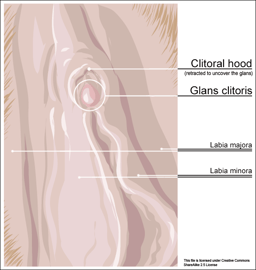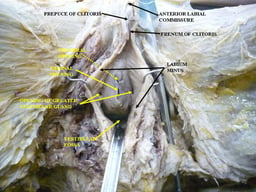Labia minora
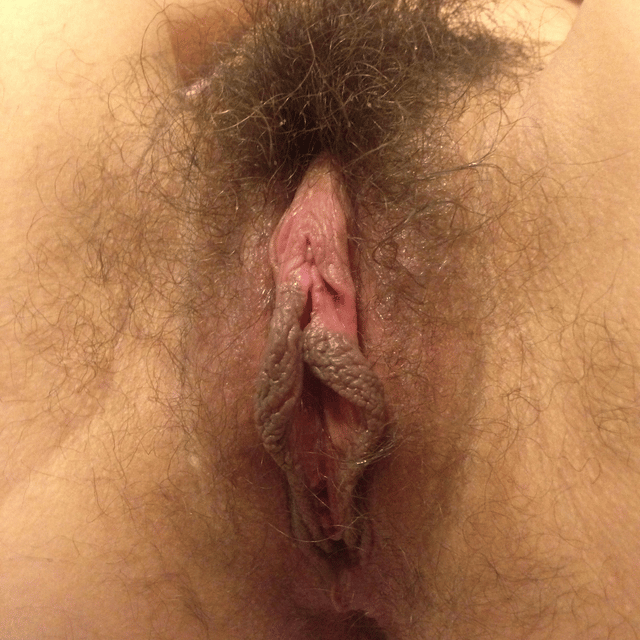
Labia minora

The labia minora (Latin for smaller lips, singular: labium minus "smaller lip"), also known as the inner labia, inner lips, vaginal lips or nymphae,[1] are two flaps of skin on either side of the human vaginal opening in the vulva, situated between the labia majora (Latin for larger lips; also called outer labia, or outer lips). The labia minora vary widely in size, color and shape from individual to individual.
Structure and functioning
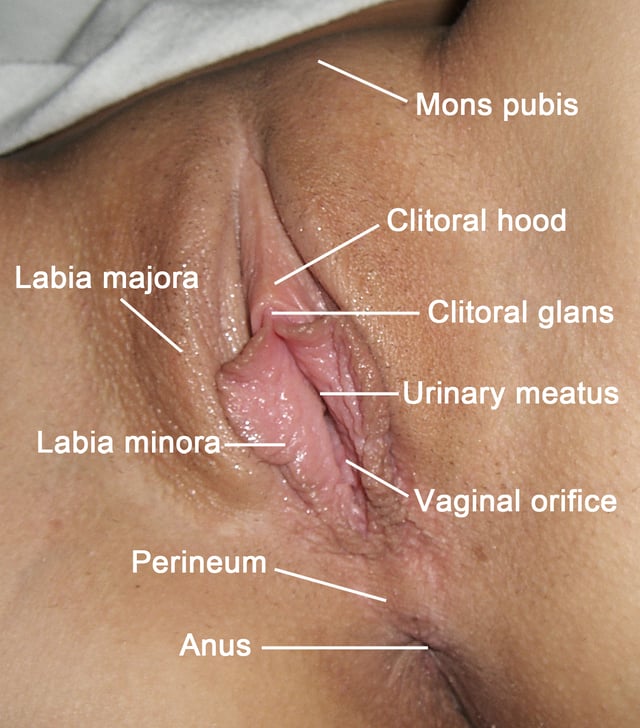
Depilated human vulva with anatomical feature labels
The labia minora extend from the clitoris obliquely downward, laterally, and backward on either side of the vulval vestibule, ending between the bottom of the vulval vestibule and the labia majora. The posterior ends (bottom) of the labia minora are usually joined across the middle line by a fold of skin, named the frenulum of labia minora or fourchette.[2]
On the front, each lip forks dividing into two portions surrounding the clitoris. The upper part of each lip passes above the clitoris to meet the upper part of the other lip—which will often be a little larger or smaller—forming a fold which overhangs the glans clitoridis (clitoral tip or head); this fold is named the clitoral hood. The lower part passes beneath the glans clitoridis and becomes united to its under surface, forming, with the inner lip of the opposite side, the frenulum clitoridis.[2]
The clitoral hood, analogously to the foreskin of the penis in men and also termed, like the latter, by the Latin word prepuce, serves to cover most of the time the shaft and sometimes the glans (which is very sensitive to the touch) to protect the clitoris from mechanical irritation and from dryness. Yet the hood is movable and can slide during clitoral erection or be pulled upwards a little for greater exposure of the clitoris to sexual stimulation.
The frenulum (Latin for little bridle) is an elastic band of tissue attached by its one end to the clitoral shaft and glans and by its other end to the prepuce. It allows two-way shifting of the clitoral hood: firstly, it can extend to let the hood be moved upwards to expose the glans for stimulation or hygienic cleansing, and secondly, it contracts to pull the hood back to protect it.
Histology
Like the whole area of the vulval vestibule, the mucus secreted by those glands protects the labia from dryness and mechanical irritation.
Variation
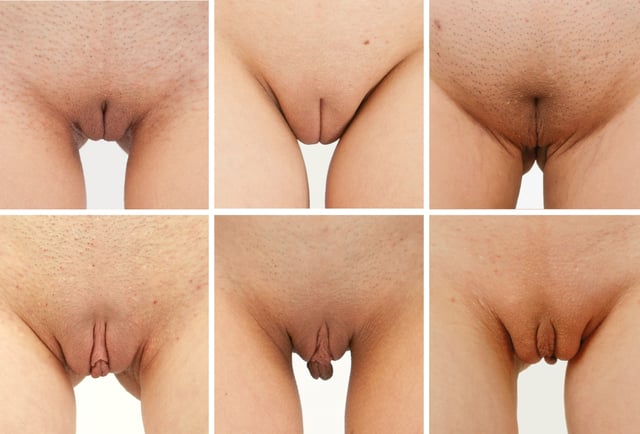
The size of labia varies between women: these pictures, with pubic hair removed to show anatomical detai, show that while the labia minora remain hidden between the labia majora in some women (top row), they "stick out" in other women (bottom row), with the protruding labia clearly visible in standing position
Being thinner than the outer labia, the inner labia can be also more narrow than the former, or wider than labia majora, thus protruding in the pudendal cleft and making the term minora (Latin for smaller) essentially inapplicable in these cases.
The reception of wider and/or longer labia varies considerably between different people, with some men and women stressing the beauty of bigger labia while other women who have such ones complain of some discomfort either from mechanical irritation by their tighter clothes or from their own or their peers' negative attitude to the image of less compact female genitalia than is stereotypical for them.
They can also be smooth or frilled, the latter being more typical of longer or wider inner labia.
From 2003 to 2004, researchers from the Department of Gynaecology, Elizabeth Garret Anderson Hospital in London, measured the labia and other genital structures of 50 women from the age of 18 to 50, with a mean age of 35.6. The results were:[4]
| Measuring | Range | Mean [SD] |
|---|---|---|
| Clitoral length (mm) | 5–35 | 19.1 [8.7] |
| Clitoral glans width (mm) | 3–10 | 5.5 [1.7] |
| Clitoris to urethra (mm) | 16–45 | 28.5 [7.1] |
| Labia majora length (cm) | 7.0–12.0 | 9.3 [1.3] |
| Labia minora length (mm) | 20–100 | 60.6 [17.2] |
| Labia minora width (mm) | 5–60 | 21.8 [9.4] |
| Perineum length (mm) | 15–55 | 31.3 [8.5] |
| Vaginal length (cm) | 6.5–12.5 | 9.6 [1.5] |
| Tanner stage (n) | IV | 4 |
| Tanner stage (n) | V | 46 |
| Colour of genital area compared with surrounding skin (n) | Same | 9 |
| Colour of genital area compared with surrounding skin (n) | Darker | 41 |
| Rugosity of labia (n) | Smooth | 14 |
| Rugosity of labia (n) | Moderate | 34 |
| Rugosity of labia (n) | Marked | 2 |
Due to the frequent portrayal of the pudendal cleft without protrusion in art and pornography, there has been a rise in the popularity of labiaplasty, surgery to alter the labia - usually, to make them smaller.[5][6][7] On the other hand, there is an opposite movement of labia stretching. Its proponents stress the beauty of long labia and their positive role in sexual stimulation of both partners.
Labiaplasty is also sometimes sought by women who have asymmetrical labia minora to adjust the shape of the structures towards identical size.
Labia stretching has traditionally been practiced in some African nations.
Functioning
The inner lips serve to protect from mechanical irritation, dryness and infections the highly sensitive area of the vulval vestibule with vaginal and urethral openings in it between them. During vaginal sexual intercourse they may contribute to stimulation of the whole vestibule area, the clitoris and the vagina of the woman and the penis of her partner. Stimulation of the clitoris may occur through tension of the clitoral hood and its frenulum by inner labia pulling at them. During sexual arousal they are lubricated by the mucus secreted in the vagina and around it to make penetration painless and protect them from irritation.
Medical conditions
Being very sensitive by their structure to any irritation, and situated in the excretion area where traces of urine, vaginal discharge, smegma and even feces may be present, the inner lips may be susceptible to inflammatory infections of the vulva such as vulvitis.
The likelihood of inflammation may be reduced through appropriate regular hygienic cleansing of the whole vulval vestibule, using water and medically tested cleansing agents designed for vulvas. To avoid contamination of the vulva with fecal bacteria, it is recommended that the vulva is washed only from front to back, from mons pubis to the perineum and anus. Apart from water and special liquid cleansing agents (lotions), there are commercially available wet wipes for female intimate hygiene. Some women wipe the vulval vestibule dry with toilet tissue after urination to avoid irritation and infections from residual drops of the urine in the area.
However, incorrect choice of cleansing agents, or their incorrect application, may itself cause labial irritation and require medical attention. Over-vigorous rubbing of the labia of little girls while washing, combined with the lack of estrogen in their bodies, may lead to the mostly pediatric condition known as labial fusion. If fused labia prevent urination, urine may accumulate and cause pain and inflammation.
In adult females, irritation of the area may be caused by wearing too-tight underwear (especially where wider inner labia protrude in the pudendal cleft); while G-strings, which rub against the labia during body movements, may cause irritation or lead to infection from bacteria transferred from either the external environment or the anus.
Additional images
See also
Femalia
Labia pride
Labia stretching
Labiaplasty

